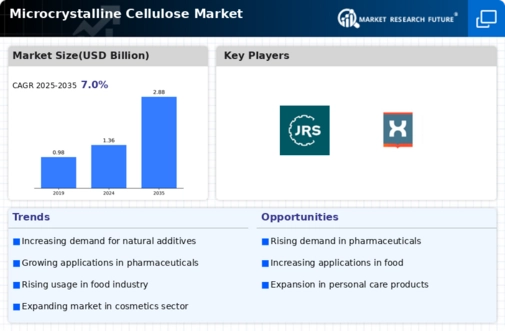Microcrystalline Cellulose Mcc Size
Microcrystalline Cellulose MCC Market Growth Projections and Opportunities
The microcrystalline cellulose market was worth 1.1 billion USD in 2021. Looking ahead, from 2022 to 2030, experts predict significant growth, projecting the market to increase from USD 1.2 billion to USD 1.85 billion at a compound annual growth rate (CAGR) of 6.78%. More and more sectors are using microcrystalline cellulose, and people are becoming more health conscious, which is driving this expansion.
Given its flexibility, microcrystalline cellulose is an essential component of a vast majority of therapeutic manufacturing processes. It is used as a binder, film former, sol, and suspension for several substances also it assists in the breakdown of the topical bases to lotions, ointments, and tablet formulations. Microcrystalline cellulose (MCC) is the main and very widely applied active ingredient in the pharmaceutical industry. Being the simultaneous glue and the major liquid, they are composed of gives it more value. Extensively, it is relied upon by tablets, capsules, sachets etc. of pharmaceuticals.
The microcrystalline cellulose market is exploding and the primary reason for its growth is the current surge in product manufacturing by pharmaceutical industry. In developing countries such as India, Brazil and China, the tendency is that the demand for microcrystalline cellulose (MCC) goes very fast.
The broad spectrum of possible uses and multiple functions of microcrystalline cellulose have been a push that has greatly influenced the fast spread in the market. Microcrystalline cellulose offers multifaceted uses that go beyond the pharmaceutical industry. These are the thickening and stabilizing properties of this substance that make it useful in the food and drinks processing industries. These properties, as a texturizer and absorbent, of microcrystalline cellulose, widely known as wood cellulose, make it a valuable ingredient in the cosmetics and personal care industries.
Another significant factor is the increasing health-related concerns of customers which is also a stimulus for microcrystalline cellulose market. In proportion to the number of people getting concerned over their health and wellbeing, the demand for such products which are both safe and useful keeps on rising. Being a versatile and safe ingredient, microcrystalline cellulose fits the growing health-oriented trend and is used by numerous industries.
Microcrystalline cellulose improves the efficacy and safety of pharmaceutical formulations when used to this industry in particular. As a binder, it keeps the contents of pills and capsules together, which improves their overall effectiveness. Its function in disintegration is also critical for the effective absorption by the body since it allows the active components to be released at the right time.



 Source: Secondary Research, Primary Research, Market Research Future Database and Analyst Review
Source: Secondary Research, Primary Research, Market Research Future Database and Analyst Review


Leave a Comment